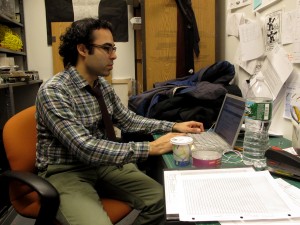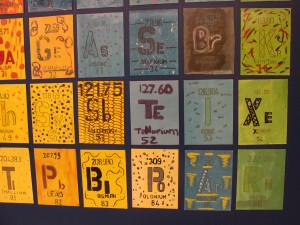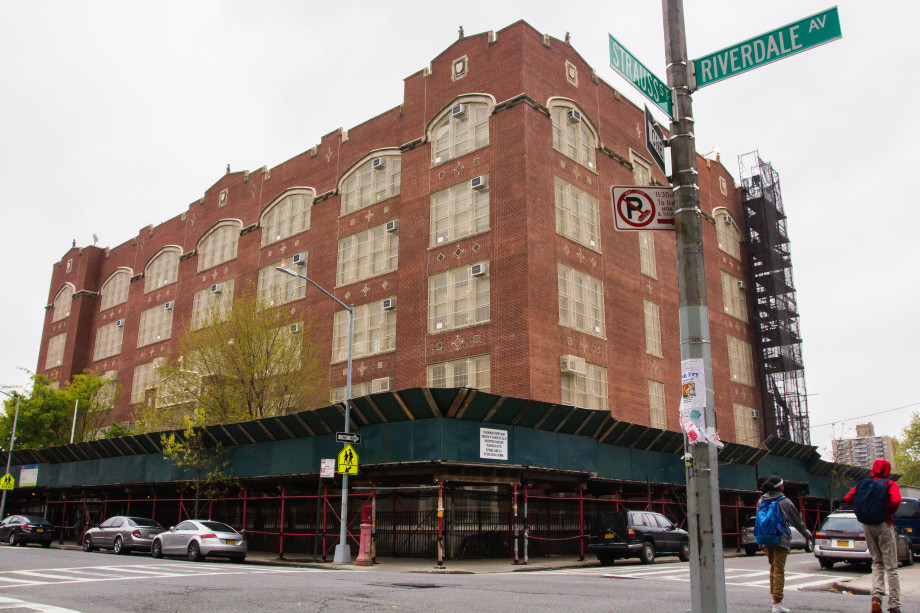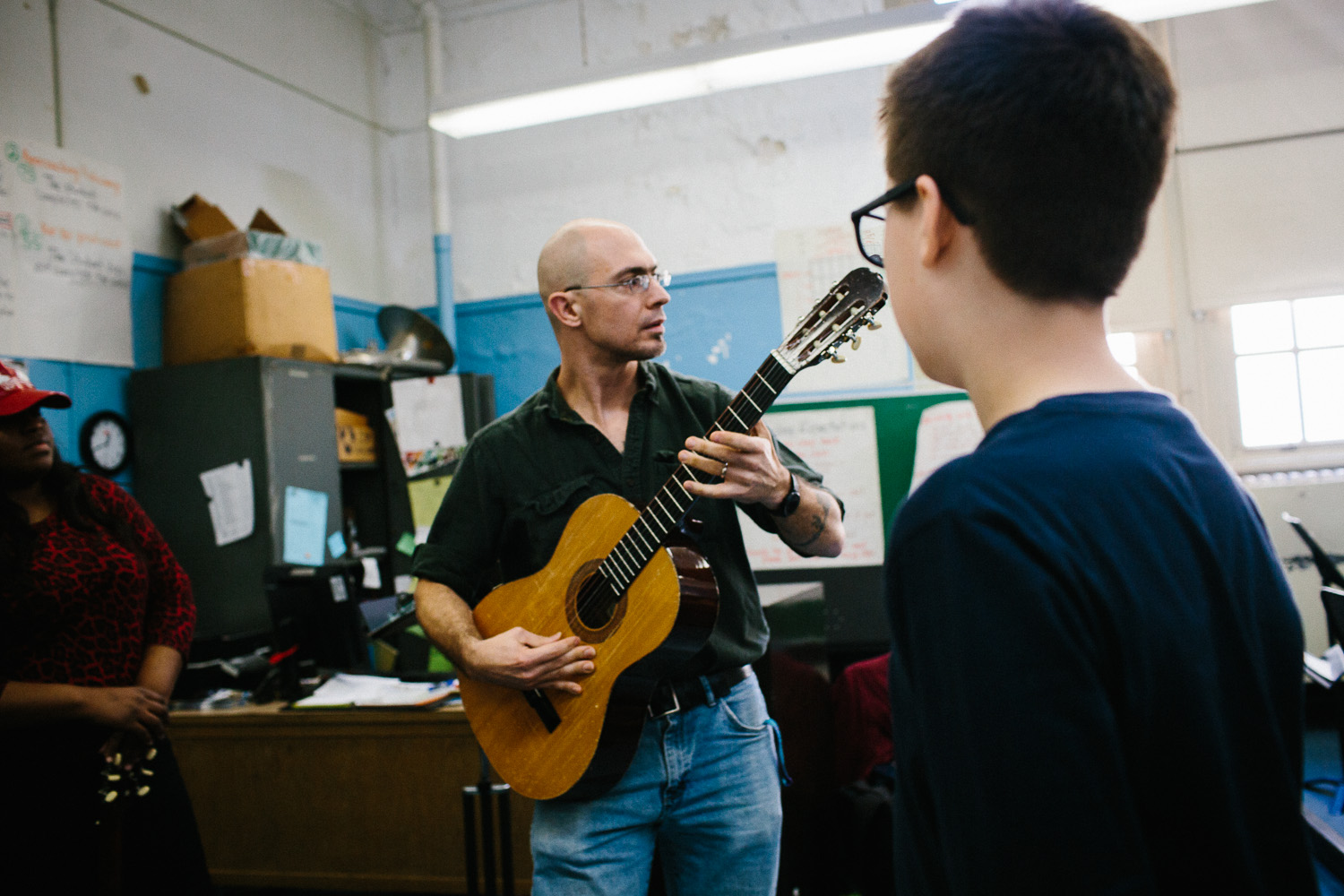
Off to the side of Eric Azcuy’s cluttered desk — next to the laptop and in front of a stack of papers — were two products from Nissin Foods: one Cup o’ Noodles and one box of Chow Mein. It looked like lunch, but it was actually the day’s art lesson.
The inspiration came from an NPR story Azcuy had read earlier describing how the
design of instant soup cups makes them tip over easily, spilling their hot contents on, and often burning, young eaters. So, Azcuy figured, why not see if his students could come up with a better, safer model for the cups?
“It’s something relevant,” he said calmly, his black, curly hair, dark-rimmed glasses and plaid collared shirt making him appear just a bit hip. “It goes to show you how important design is.”
The lesson plan was typical for Azcuy, 35, who is in his sixth year of teaching art at the Urban Assembly School for Applied Math and Science (A.M.S.) in the South Bronx, a traditional public school founded in 2004 that serves nearly 600 students in grades 6 through 12, 91 percent of whom come from low-income families. It gives the students a chance to be creative while also letting them know that art can have some practical applications, even for those who don’t intend on becoming the next da Vinci.
That approach has led to projects that range from painting a giant periodic table of the elements to creating a mural based on The Great Gatsby to, today, improving the design of a cup of soup. Still, Azcuy doesn’t rely exclusively on these types of assignments. He recognizes that sometimes it’s best to just let his students use art class as a time to draw.
“It can also function as an escape to a place that has nothing to do with the tests and the SAT and the college pressure and this kind of thing that’s happening in a lot of their classes,” he said. “It’s like a way for them to just zone into their art and creative world.”
Art has functioned as a refuge for Azcuy from a very young age. He found quiet moments difficult to come by growing up in his Park Slope brownstone, given that he had three cousins who lived upstairs and a constant stream of friends and neighbors coming in and out. Whenever Azcuy needed a break from all the noise, he would start working on an art project, and things would all of a sudden get much more serene.
“When I was drawing, everyone would leave me alone,” he said. “It was kind of an escape from this busy, wild household.”
Azcuy’s love of art would eventually take him to LaGuardia High School, Cooper Union, and Columbia University for a Master of Fine Arts. Although he did spend some time trying to live off of his artwork after graduating from Columbia, he was

not doing anything particularly artistic when he heard of the teaching position at A.M.S. Instead, he was helping a friend run a grant-based work readiness program. When this program lost its grant money, however, it forced Azcuy to look for a new job, preferably one that would give him an opportunity to be creative again.
“I felt a little bit removed from my passion, sitting at a desk all day,” he said. “So I decided, well, let me try to teach art.”
Azcuy first saw the opening at A.M.S. posted on one of the country’s most reliable sources of information: Craigslist. The amount of description in the ad made it seem much more legitimate and enticing than the typical posting for a three-bedroom, $45-a-month apartment.
“It just looked … like the person who wrote it was exciting and wanted to get a good art teacher,” he said. “It wasn’t just a list of qualifications, but it was actually a written ad that someone wrote with a few paragraphs.”
Azcuy was initially brought on as a substitute, but he was hired fulltime after the school’s previous art teacher went on pregnancy leave and didn’t come back. He began linking his students’ art projects with material they were learning in their academics almost immediately.
One of the first things he had his sixth graders do, for example, was use four drawings to transform an object they had in front of them into an object from their imagination. The first drawing would be 100 percent object, the last would be 100 percent imagination, and the second and third would be 75 percent object, 25 percent imagination, and vice versa. In other words, this wasn’t just a chance for students to transform a stapler into a five-headed dragon. It was also a chance for them to understand how percentages could be visually conveyed.
“The math, it was kind of just snuck in there,” Azcuy said. “They don’t really notice it. It’s snuck in under the fun of art.
“Some kids catch on,” he acknowledged, chuckling. “They’re like, ‘Oh, this is math! This is math!’ And I’ll just bring it back to art. ‘Well, look at this crazy cool thing that you could make!’”
Azcuy has found several benefits to teaching art class this way. It allows students to see that art is “in everything,” not just in one large, paint-splotched room of A.M.S. It gives students who aren’t as naturally gifted at drawing a chance to do well on the academic parts of the projects. And it’s a lot of fun, too.
“The more linked different subjects are, the less they are different subjects,” said Azcuy. “The more it’s just about the learning experience, and I think it’s just more comfortable for them.”
Azcuy began his Feb. 8 sketchbook class by placing the Cup o’ Noodles on a board, holding it up in front of his 14 students, and tilting it to illustrate how quickly the cup could fall over. He then did the same with the more rectangular Chow Mein, which slid down slowly while remaining upright, to give his students an idea of what type of redesign they might attempt.
It was an effective demonstration of the problems with one design and the potential of another. But given that Azcuy delivered it to a room full of teenagers, it didn’t take long for the sarcastic, contrarian comment to arrive.
“Why you got a kid that doesn’t know how to eat?” asked one student, loudly blaming stupid children and neglectful parents — not the container — for the spills. A few others said they didn’t want to change the design because that would also mean changing the name from Cup Noodles to Bowl Noodles.
But once Azcuy finished explaining the assignment and told his students to start drawing, any tension from the first few minutes disappeared. The students dove into their sketchbooks. Azcuy checked on their progress individually and put on some quiet hip-hop beats to serve as background noise, and what he refers to as a “cool, relaxed, art-making vibe” took over the class.
“This room … it’s like a creative kind of space for them,” Azcuy said of his students. “A safe, creative space where they can feel free and comfortable to explore things.”
Most of the students in Azcuy’s sketchbook class agreed with this description. They applied it not just to the room but to Azcuy himself as well.
“He lets you express your feelings,” said junior Joel Tolentino. “It’s a good stress reliever.”
“It’s a calm class,” echoed sophomore Julio Martinez. “There’s no stress here.”
The students did have one criticism of Azcuy, however.
“Sometimes he can be a little corny with his jokes,” said sophomore Jahdiel Ventura, “but he’s alright, though.”
“He’s kind of corny, but he’s a good teacher,” agreed junior Helen Morales.
“Alright guys, we’re gonna wrap it up like Run-DMC!” Azcuy exclaimed a few minutes later, just as class was about to end. Most of his students had opted to make their new Cup Noodles similar to the rectangular design of the Chow Mein, although a few got more imaginative. One student’s design, for instance, included wings. It is not clear how they helped make the container more stable, but they did look pretty cool.
The sketchbook class quickly filed out after the bell rang, but the art room would soon be full again based on a simple deal Azcuy has with the A.M.S. students: If they

want to work on something art related and don’t bother anyone, they can spend their lunch period in his classroom. This has proven to be a very popular deal so far.
“At lunchtime, they are dying to get out of the cafeteria,” said A.M.S. principal Ken Baum. “I may have to move the cafeteria to the art room if this keeps up.”
Azcuy has no plans to stop teaching or leave A.M.S. anytime soon; he’s far too excited about the opportunity to grow the school’s art program. The one word that keeps coming up when he discusses the future is “more.” More classes, more field trips, and more collaboration — all while the married father of one (soon to be two) makes sure to maintain a balance between his work life and his home life.
“I feel like it’s also important to let go in order for me to rejuvenate my creative self,” he said. “To then bring that back to the students so I’m not this kind of rundown person in the front of the room.
“It’s a balancing act,” he continued. “That’s what life is for everyone, I guess.”



